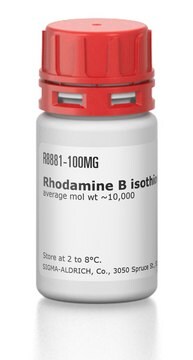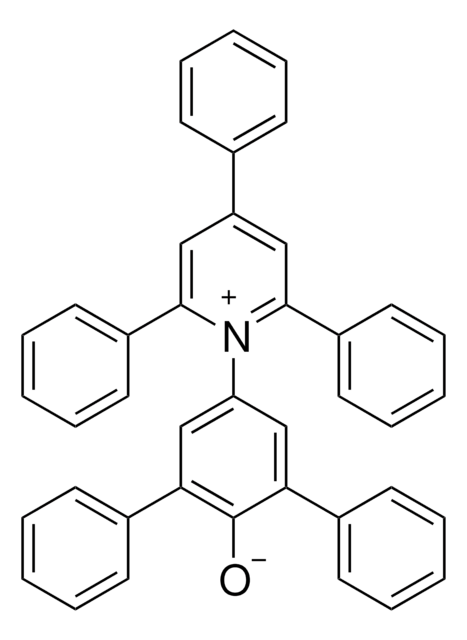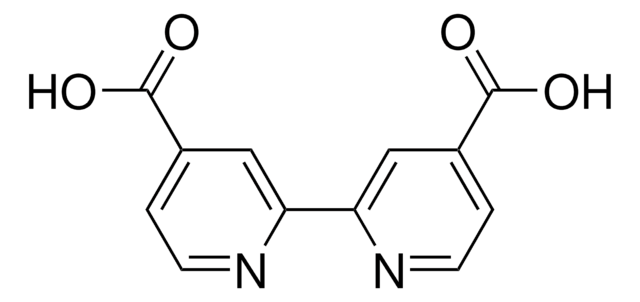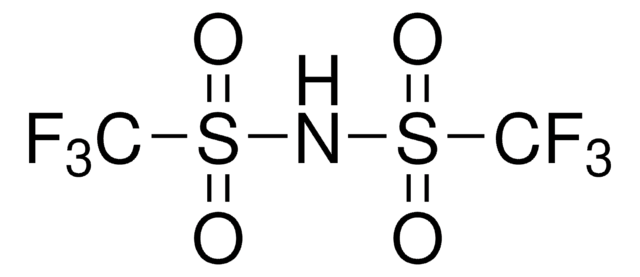791415
K19 Dye
85% (HPLC)
Sinónimos:
Greatcell Solar®, K 19 sensitizer, Ru(4,4-dicarboxylic acid-2,2′-bipyridine)(4,4′-bis(p-hexyloxystyryl)-2,2-bipyridine)(NCS)2
About This Item
Productos recomendados
assay
85% (HPLC)
form
powder (black)
mp
>300 °C
λmax
536, 357, 311 nm at 0.02 mM in DMF (lit.)
SMILES string
OC(C1=CC(C2=CC(C(O)=O)=CC=N2)=NC=C1)=O.S=C=N[Ru]N=C=S.CCCCCCOC(C=C3)=CC=C3/C=C/C4=CC=NC(C5=NC=CC(/C=C/C6=CC=C(OCCCCCC)C=C6)=C5)=C4
InChI
1S/C38H44N2O2.C12H8N2O4.2CNS.Ru/c1-3-5-7-9-27-41-35-19-15-31(16-20-35)11-13-33-23-25-39-37(29-33)38-30-34(24-26-40-38)14-12-32-17-21-36(22-18-32)42-28-10-8-6-4-2;15-11(16)7-1-3-13-9(5-7)10-6-8(12(17)18)2-4-14-10;2*2-1-3;/h11-26,29-30H,3-10,27-28H2,1-2H3;1-6H,(H,15,16)(H,17,18);;;/q;;2*-1;+2/b13-11+,14-12+;;;;
InChI key
HBARXZGSEMEPLK-BPSJQPAOSA-N
General description
Application
Legal Information
Greatcell Solar is a registered trademark of Greatcell Solar Materials Pty Ltd.
signalword
Warning
hcodes
Hazard Classifications
Eye Irrit. 2 - Skin Irrit. 2 - Skin Sens. 1 - STOT SE 3
target_organs
Respiratory system
Storage Class
11 - Combustible Solids
wgk_germany
WGK 3
flash_point_f
Not applicable
flash_point_c
Not applicable
Elija entre una de las versiones más recientes:
Certificados de análisis (COA)
¿No ve la versión correcta?
Si necesita una versión concreta, puede buscar un certificado específico por el número de lote.
¿Ya tiene este producto?
Encuentre la documentación para los productos que ha comprado recientemente en la Biblioteca de documentos.
Los clientes también vieron
Artículos
While dye sensitization as the basis for color photography has been accepted for a very long time,1 attempts to use this principle for the conversion of solar light to electricity generally had resulted only in very low photocurrents, below 100 nA/cm
Nuestro equipo de científicos tiene experiencia en todas las áreas de investigación: Ciencias de la vida, Ciencia de los materiales, Síntesis química, Cromatografía, Analítica y muchas otras.
Póngase en contacto con el Servicio técnico













